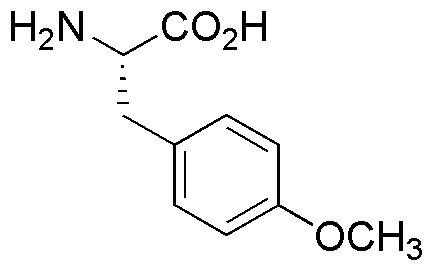O-Methyl-L-tyrosine is widely utilized in research focused on:
- Neuroscience Research: This compound serves as a valuable tool for studying neurotransmitter synthesis, particularly dopamine, which is crucial for understanding various neurological disorders.
- Pharmaceutical Development: It is used in the development of drugs targeting conditions like Parkinson's disease, as it can help modulate dopamine levels, offering potential therapeutic benefits.
- Nutrition Science: O-Methyl-L-tyrosine is explored for its role in protein synthesis and amino acid metabolism, providing insights into dietary impacts on health and disease.
- Biochemical Studies: Researchers utilize this compound to investigate the effects of methylation on amino acids, contributing to a deeper understanding of metabolic pathways.
- Animal Studies: It is often used in animal models to assess the impact of altered tyrosine levels on behavior and physiological responses, aiding in the development of new treatments.
General Information
Properties
Safety and Regulations
Applications
O-Methyl-L-tyrosine is widely utilized in research focused on:
- Neuroscience Research: This compound serves as a valuable tool for studying neurotransmitter synthesis, particularly dopamine, which is crucial for understanding various neurological disorders.
- Pharmaceutical Development: It is used in the development of drugs targeting conditions like Parkinson's disease, as it can help modulate dopamine levels, offering potential therapeutic benefits.
- Nutrition Science: O-Methyl-L-tyrosine is explored for its role in protein synthesis and amino acid metabolism, providing insights into dietary impacts on health and disease.
- Biochemical Studies: Researchers utilize this compound to investigate the effects of methylation on amino acids, contributing to a deeper understanding of metabolic pathways.
- Animal Studies: It is often used in animal models to assess the impact of altered tyrosine levels on behavior and physiological responses, aiding in the development of new treatments.
Documents
Safety Data Sheets (SDS)
The SDS provides comprehensive safety information on handling, storage, and disposal of the product.
Product Specification (PS)
The PS provides a comprehensive breakdown of the product’s properties, including chemical composition, physical state, purity, and storage requirements. It also details acceptable quality ranges and the product's intended applications.
Certificates of Analysis (COA)
Search for Certificates of Analysis (COA) by entering the products Lot Number. Lot and Batch Numbers can be found on a product’s label following the words ‘Lot’ or ‘Batch’.
*Catalog Number
*Lot Number
Certificates Of Origin (COO)
This COO confirms the country where the product was manufactured, and also details the materials and components used in it and whether it is derived from natural, synthetic, or other specific sources. This certificate may be required for customs, trade, and regulatory compliance.
*Catalog Number
*Lot Number
Safety Data Sheets (SDS)
The SDS provides comprehensive safety information on handling, storage, and disposal of the product.
DownloadProduct Specification (PS)
The PS provides a comprehensive breakdown of the product’s properties, including chemical composition, physical state, purity, and storage requirements. It also details acceptable quality ranges and the product's intended applications.
DownloadCertificates of Analysis (COA)
Search for Certificates of Analysis (COA) by entering the products Lot Number. Lot and Batch Numbers can be found on a product’s label following the words ‘Lot’ or ‘Batch’.
*Catalog Number
*Lot Number
Certificates Of Origin (COO)
This COO confirms the country where the product was manufactured, and also details the materials and components used in it and whether it is derived from natural, synthetic, or other specific sources. This certificate may be required for customs, trade, and regulatory compliance.


